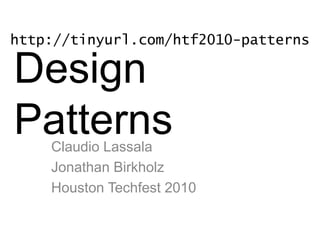Techfest design patterns
- 1. Design PatternsClaudio Lassala Jonathan Birkholz Houston Techfest 2010 http://tinyurl.com/htf2010-patterns
- 3. EPS As an attendee to this session, you are entitled to a free CODE subscription! ÔÅä www.codemag.com/subscribe/htf10 Software Projects Consulting Training Publishers of CODE Magazine The .Net Knowledge Powerho
- 4. Chaione Strategy and Planning User Experience Design Mobile Solutions Web Solutions
- 5. :url => snipr.com/virtualaltnet :website => www.virtualbrownbag.com :when => every Thursday from 12pm – 1pm Where everyone can come talk and learn about software development
- 6. Learnsomething about design patterns Apply Teach your knowledge at your day job others what you have learned
- 8. is the only constant in software development Change
- 9. change in software is time consuming expensive fail and is why projects
- 10. successful best practicif only there were some on how to manage change so that our software projects can be
- 11. Design Patternsdescribe a concept or process on an abstract level. These patterns arose from repeated successful applications on how to design software to adapt to change
- 12. Design patterns also provide a conciseform of communication among professionals
- 14. Ok… so…. I’m going to pretend to hand off the ball but really I am going to pass it. The hope is the defense will be confused for a few seconds so that can create an opening and one of you guys can get open Play Action Pass? meanwhile a well organized team is already running their play More effective commu
- 15. If design patterns are known best practices why are there no frameworks or libraries for design patterns? more about form and context than code allegory of the cave
- 17. Princip lesProgram to interface, not to implementation Strive for loosely coupled designs between objects that interact Favor composition over inheritance SOLID Principles => form => design pattern
- 18. Cash Register Learning through code is best
- 19. LOOK AT CODE
- 20. REFACTOR
- 21. Command Pattern is a design pattern in which an object is used to represent and encapsulate all the information needed to execute an operation at a later time
- 22. with commands you can also… Queue Log Undo commands in the form of a macro command thereby handling complexity through composition command execution for future diagnosis of problems and bugs more easily support
- 23. Experiences with Command Pattern Where the Command Pattern can be found in .Net
- 24. REFACTOR
- 25. Façade Pattern provides a unified interface to a set of interfaces in a subsystem. To put it simply, it makes the complex easy.
- 27. Too many remotes! Ugh! subsystems facade Ah… one remote to ru
- 28. Experiences with Façade Pattern Where the Façade Pattern can be found in .Net
- 29. REFACTOR
- 30. Observer Pattern defines a dependency between objects so that when one object changes, dependent objects can be notified Publishers + Subscribers = Observer Pattern
- 31. Stop Pestering… Let subject call observers actively querying state on subject passi ve
- 32. Hollywood PrincipleDon’t call us, we’ll call you. Register Scanner add item item scanned
- 33. Experiences with Observer Pattern Where the Observer Pattern can be found in .Net
- 34. REFACTOR
- 35. Adapter Pattern converts the interface of a class into another interface the clients expect
- 36. Experiences with Adapter Pattern Where the Adapter Pattern can be found in .Net
- 38. Proxy Pattern provides a surrogate or placeholder for another object to control access to it. Proxy Real
- 39. REFACTOR
- 40. Strategy Pattern defines a family of algorithms, encapsulates each one, and makes them interchangeable. This lets the algorithm vary independently from clients that use it.
- 42. King Queen Bishop Rook Knight Pawn how are they different?
- 43. Experiences with Strategy Pattern Where the Strategy Pattern can be found in .Net
- 44. REFACTOR
- 45. Factory Pattern provides an interface for creating families of related or dependent objects
- 46. Types of Factories Factory Method Factory Class Abstract Factory
- 47. Experiences with Factory Pattern Where the Factory Pattern can be found in .Net
- 48. Other Patterns • Decorator • Mediator • Iterator • Builder • Composition • Visitor • Chain of Responsibility Presentation Patterns • MVC • MVVM • MVP
- 49. Bookshelf
- 50. Questions http://tinyurl.com/htf2010-patterns claudio@eps-software.com ClaudioLassala.workpress.com @claudiolassala EPS Software Corp jb@chaione.com theabsentmindedcoder.com @rookieone wizardsofsmart.net github.com/RookieOne bitbucket.org/rookieone Chaione Join us at www.VirtualBrownBag.com every Thursday 12pm -1pm

















































